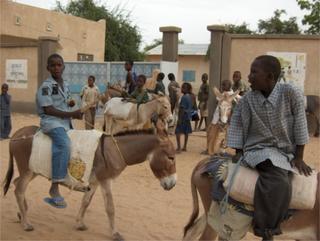
Since August CARE Niger has been in the middle of a whirlwind of activity distributing food aid from the WFP to hungry communities in the regions of Tahoua, Maradi and Diffa. The scale of the operation is enormous and has consumed nearly all of the resources, time and energy of CARE’s dedicated workforce. The hard work and sacrifice will have been worth the result: by the end of the operation, set for October 10, CARE will have distributed over 16,000 tons of food to 900,000 people in Niger. In a place where just-in-time delivery is still a fantasy, this accomplishment—in only 8 weeks—is nothing short of miraculous.
That the food even made it to the communities is equally miraculous. A sac of maize grown in Iowa and consumed in N’Guigmi, Niger has come a long way. And nearly every imaginable mode of transportation has been used to move the sac along its journey. But there is one mode of transportation that stands out from the others as unique and noteworthy. When the trucks discharge their food in the communities, the most critical distance—from distribution point to household—is often serviced by the poor man’s SUV, the lowly donkey.
In Niger you cannot talk of donkeys and not mention the young boys that tend them, for they go hand in hand. What can you say about a boy and his donkey? I won’t suggest that the bond is on par with that seen between Timmy and Lassie, but there is something special there. And, years from now, 2005 will likely stand out in the minds of many Nigerien boys as the year that CARE International brought their community food, and as the year they made bank—thanks to their trusty steed.
The distributions have had an unintended—and positive—economic impact in the small and often neglected demographic of prepubescent entrepreneur. If, at each stage of transportation, someone has received payment for rendered services associated with the food rations, why should the donkey boys be any different?
What kind of economic impact has the donkey transport business had in Niger? Let’s do some hypothesizing using Diffa as an example. In Diffa, the going rate for transporting a 50 kg bag of cereal is 40 Naira (approximately 30 cents). CARE will distribute 3,000 tons of cereal in this region. If donkeys deliver 1,000 tons (20,000 sacs) from distribution center to household, they would generate an income of US $6,000 for their owners. In a place where the GNP is only US $170, this is serious cash.
In the process, not only do these boys earn some pocket money, they also learn some important business lessons. First-mover advantage is applicable here. Those boys who showed up first with their donkeys had a captive market and could reap the lion’s share of any profits. But they then learned that first-mover advantage dissipates quickly in the face of competition. They learn about barriers to entry, which, for donkey transport, are fairly low: If you have a donkey, you can play. And, when distributions finally come to an end, they will need to learn the cruel lesson of what happens when supply outstrips demand.
The donkey also gets an education in economics from this experience. It learns that if trickle down economics can’t work in the United States that it won’t work in Niger either. For all its hard work, the donkey probably didn’t receive any improved rations. Even Lassie would have earned a choice bone if she had earned Timmy a quick 20 bucks.

1 comment:
Dan. You are the man. Seriously. Loving your writing. I check this site every couple of days, very into hearing about what's up in Niger.
Hi to any Zinder PC folks if you happen by there. Andrea and Ellie are awesome. I'll send you a personal email. But I thought you needed some comments publicly posted. You're effing brilliant, if I may say.
Post a Comment